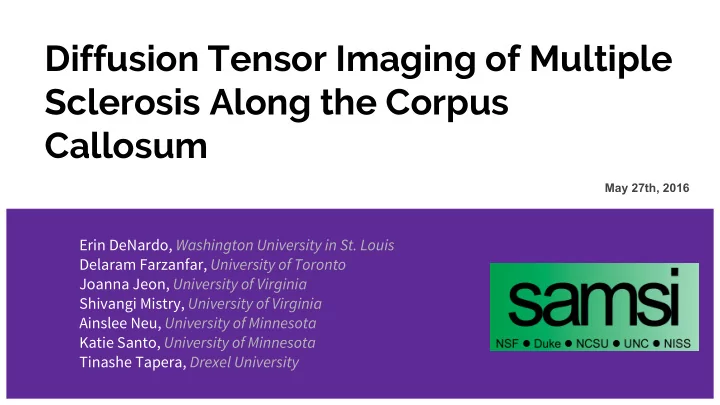

Diffusion Tensor Imaging of Multiple Sclerosis Along the Corpus Callosum May 27th, 2016 Erin DeNardo, Washington University in St. Louis Delaram Farzanfar, University of Toronto Joanna Jeon, University of Virginia Shivangi Mistry, University of Virginia Ainslee Neu, University of Minnesota Katie Santo, University of Minnesota Tinashe Tapera, Drexel University
Research Question Do water diffusion profiles along the corpus callosum fibers correlate with the diagnosis of multiple sclerosis ? Understand how diffusion properties are changing along the callosal fiber ○ tracts Predict the likelihood of having MS based on the FA values and gender ○
Multiple Sclerosis Damage to myelin sheath; protective ● tissue covering axons Transmission of nerve impulses ● impaired Damage may be caused by ● inflammation, lesions, scars, plaques scattered throughout the CNS Common symptoms include ● autonomic, visual, motor & sensory problems
What is Diffusion Tensor Imaging…? MRI based imaging method ● Sensitive to microscopic Higher FA Lower FA ● motion of water molecules Water molecule movement ● is different in different tissues Sensitive to disruption of ● tissue microstructure www.na-mic.org Closer to 0 Closer to 1
Callosal Fibers Left Right http://www.intropsych. com/ch02_human_nervous_system/hemisphe ric_specialization.html
Data Visualisation: Mean Data and Differences of Means Data Source: MRI/DTI data were collected at Johns Hopkins University and Kennedy-Krieger Institute
Data Visualisation: Q-Q Plots
Identifying the Difference between MS and Control Points: Independent T-tests
Methodical Approach 4. Functional Model Independent T-tests at each location ● Logistic Regression Models ● 1. Overall (all 93 points) ○ 2. Grouped (split into 3 sections of 31 points) ○ 3. Alternating (every 10th point) ○ 4. Functional Model ○ 1. All Data Points 2. Three equal segments 3. Every 10th Point
Logistic Regression We have a binary output variable MS, and we want to model the conditional probability Pr( MS = 1 | X = x) as a function of x. Likelihood of binary response determined via the Log-Likelihood ratio. Log-likelihood:
Train & Test Validation Data Set 95% 5% Train Training Set Test Set # Test on Correct on 1 S 2 ...S 93 S 1 90/93 Learning Learned model S 1 ,S 3 ... 2 S 2 75/93 S 93 Prediction Accuracy Estimate
Regression Models
Overall Model (Using All Points) Assumes that all points along corpus callosum are predictive ● There is high collinearity ● High standard errors ● Very large P-values ● No points are significant ● Due to high correlation between adjacent points ● Prediction accuracy 66% ●
Grouped Model (3 Equal Segments) We originally suspected that the peaks may represent specific regions ● May be biologically informed ● For practical purposes, we simplified the segments into equal lengths ● Each of the three predictors were significant ● Region 1: p < 0.001 ○ Region 2: p < 0.001 ○ Region 3: p < 0.001 ○ Prediction accuracy 76% ●
Alternating Model (Every 10th) Reduce the number of predictors ● Increase the distance between the points ● Two points 13 ( p > 0.037) and 73 ( p > 0.024) were significant ● Prediction accuracy 71% ●
Functional Model Functional data analysis ● Model: Functional ● Generalized Additive Model (FGAM) CCA data as function as ● predictor of case status Equation that FGAM is based on:
Model Prediction Accuracy Model Prediction AIC Accuracy Overall 66% 190 Grouped 76% 4281* Alternating 71% 141 *To be discussed
Limitations Age not taken into consideration ● Model not informed by intrinsic variability along the posterior-anterior direction ● No information on the approximate location of the start and end points ● Only the first scan analyzed for patients with multiple scans ●
Future Directions Find the normal range of variability between different ● portions of the tract Develop better diagnostic criteria for MS ● Faster diagnosis for earlier treatment course ○ Presence of periventricular lesions as a hallmark of MS ● Lower FA values in the middle section related to proximity to ○ Lateral ventricles ? How does this data relate to variability along the medial plane ? ○ Aldasoro-Cáceres V, et al. 2014 Jan 31;89(1):31-4.
Thank you ! Questions?
Recommend
More recommend